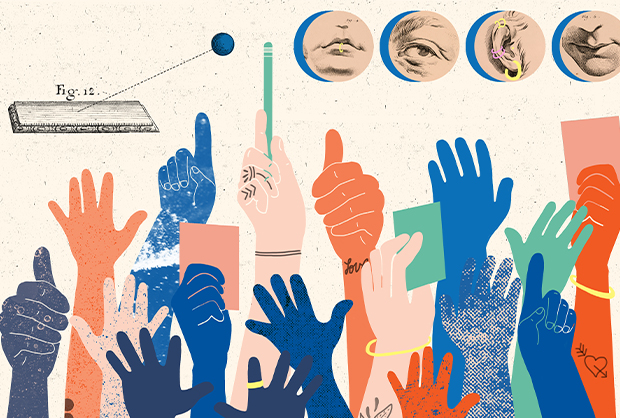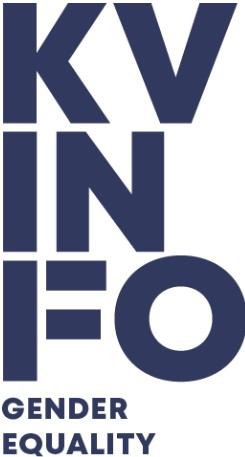Knowledge
Political representation

That is why we often talk about representation when we talk about gender equality and who are able and want to participate in a country’s political life.
Women’s entry into Danish politics was a milestone in the development of democracy. But we still face major challenges in terms of representation and participation in the democracy. The elected politicians do not accurately reflect the composition of the population when we look at gender, age, ethnicity and educational background.
Gender and culture in municipal politics
During the municipal elections in 2021, KVINFO investigated what gender means for running and participating in local politics in Denmark. You can read the results in the report Gender and culture in local government policy – A study of gender discrimination and sexual harassment in local government policy at this link.
Democratic loss
In short: a homogeneous representation results in a one-sided agenda and lack of essential perspectives.
Several studies show that lack of fair representation in positions of power, for example as we see it on the political scene, is a democratic problem. It is less likely that one can relate to society and will feel motivated to engage politically, if one does not see oneself represented among decision makers. Ultimately, it can create the feeling of exclusion, which is a democratic problem.
Another factor is the political work environment.
For many years in Denmark, we have talked about how the political parties can attract more women into, for example, municipal politics.
The inequality in gender representation in municipal politics is often explained by the fact that women find it difficult to attend city council meetings because they are scheduled at night, when children are put to bed. But this simplification is not true.
There are indications that the link between discrimination and sexual harassment on the one hand and the low representation of women on the other, has been overlooked. In municipal politics as elsewhere, sexual harassment and discrimination affect women to a much greater extent than men.
Transgressive behavior among youth parties
The poor conditions for women are not unique to municipal politics. In political youth parties, 46 percent of the women surveyed have been subjected to sexually transgressive behavior or abuse within the past two years. For men, the proportion was 24 percent, according to a report from Sex & Samfund og Børns Vilkår.
The harmful culture limits young people in their political ambitions. When the culture harms women far more than men, even among young politicians, it causes some women to lose interest in politics.
“As a society, we have a problem when an entire population group hesitates or does not participate in politics at all. We miss out on the entire group’s knowledge, experiences and ideas, and this is of course a democratic problem that we must take seriously, ”says KVINFO’s director Henriette Laursen.
At KVINFO, we believe that we need to focus more on how we can create an environment that makes local politics more attractive for women to participate in. And how we can retain the women who are already interested in municipal politics.

KVINFO works internationally with political participation
For years, KVINFO has worked with political participation internationally and specifically in the Middle East and North Africa.
KVINFO’s international work is funded by the Ministry of Foreign Affairs’ Danish-Arab Partnership Program (DAPP), the European Union and the Novo Nordisk Foundation.
Political representation internationally
Lack of gender balance and representation on the political scene is not just a Danish phenomenon. It is a global challenge.
Recent data from UN Women show that despite increases in the number of women at the highest levels of political power, there is still widespread gender inequality.
Progress among women with ministerial posts is declining, with only a slight increase from 21.3 percent in 2020 to 21.9 percent in 2021.
The number of countries without women in government has increased, and only 25.5 percent of national parliamentarians are women, compared to 24.9 percent the year before.
UN Women’s figures show that in 2021 women are heads of state or government in 22 countries against 20 countries by 2020. January 1, 2021, 5.9 percent of the elected heads of state and 6.7 per. percent of heads of government are women. In total, this corresponds to 9 women out of 152 elected heads of state and 13 women out of 193 heads of state.
Europe is the region with the most countries led by women: five out of nine heads of state and seven out of 13 heads of government. Four Nordic countries – Denmark, Finland, Iceland and Sweden – are all currently led by women.
Fewer gender equal governments
The number of countries where women hold 50 percent or more of ministerial posts fell from 14 in 2020 to 13 in 2021.
Countries with 50 percent or more female ministers:
Nicaragua – 58.82%
Austria – 57.14%
Sweden – 57.14%
Belgium – 57.14%
Albania – 56.25%
Rwanda – 54.84%
Costa Rica – 52.00%
Canada – 51.43%
Andorra, Finland, France, Guinea-Bissau, Spain – 50.00%
You can explore the status of political representation on the map Women in politics: 2021. produced by the Inter-Parliamentary Union (IPU) and UN Women.
Political participation in the Middle East and North Africa
In the Middle East and North Africa region, Lebanon currently has the largest share of women ministers with 31.6 percent. Tunisia saw the largest increase, from 6.9 percent to 29.2 percent in 2020.
Men and women have different opportunities to take an active part in the political life of Morocco, Tunisia, Egypt and Jordan, and women are generally less active and less well represented than men. KVINFO’s international work focuses on enabling women to take part in their country’s political life. This is done both by working for rules and legislation for equal representation and by training women to play a qualified role.
Morocco
KVINFO’s partner in Morocco, the Fédération des Ligues des Droits des Femmes (FLDF), emphasises in a report from July 2021 that women’s participation in political parties remains weak despite, among other things, the new constitution that should ensure gender equality.
There are still socio-cultural, economic and political barriers to equal political participation between the genders. This is evident in the recent election in September 2021 and the new development plan for Morocco. On the basis of a quota, it is true that 30 more women entered the national parliament compared to before the election, but the organization FLDF notes that the political parties themselves help to limit women’s activism and political participation because they do not take initiatives to ensure equal participation. The recent revision of the election law was a great opportunity, but the parties did not seize it.
The new development plan for Morocco, which was also adopted in 2021, neglects to address gender equality in a number of areas. The FLDF therefore calls for gender equality to be made a national priority, and is in this connection attaches hopeful towards the new liberal governing coalition in Morocco.
In the 2021 election, for the first time in the country’s political history, Morocco had seven female ministers. However, a single woman resigned her ministerial post after a few days to hold on to her mayoral post full-time, and there are therefore six female ministers presently, which is still a historic record.
Tunisia
After ten years of work and considerable victories for gender equality in politics in Tunisia, women’s and gender equality organizations are facing a challenge, the extent of which is unknown .
In July 2021, the President abruptly dismantled the country’s democratic process, deposed the government and suspended parliament as well as large parts of the constitution indefinitely. The president is expected to initiate an amended constitution as well as an election law, and gender equality organizations are already working hard to ensure that progress over the past ten years is not eliminated in the process.
Egypt
Politically, the abolition of the women’s quota for parliamentary elections in the 2012 election was a major setback for women’s political representation. The new election law does not contain any regulations to ensure a fair representation of women in e.g. election lists.
In addition, phenomena such as arbitrary sexual harassment and the regular use of systematic assault on women during demonstrations are hampering with women’s active participation in political and public life in Egypt.
ARAB DEVELOPMENT IN NUMBERS AND STATISTICS
Population, gender, security and opportunities. These are some of the topics measured, analyzed and described in the UN Arab Human Development Report (AHDR). The UN Development Organization, UNDP, is responsible for AHDR.
Jordan
In 2020, Jordan saw a 44 percent increase in female candidates for the general election compared to the 2016 election.
For the first time in the country’s history, three electoral lists with all candidates being women competed, and a proportion of women outside the fixed quota of 15 seats for women in parliament.
However, no women were elected beyond the 15-seat quota. It is a step backwards for representation in politics, as five women were elected beyond the quota in the previous election in 2016.

